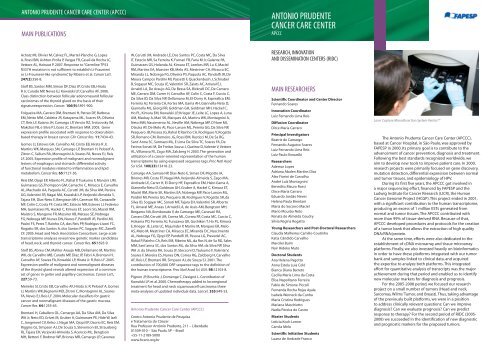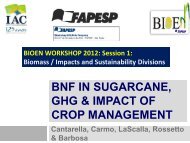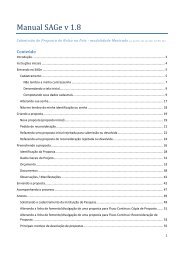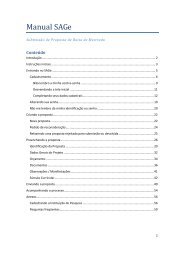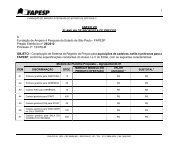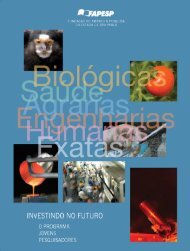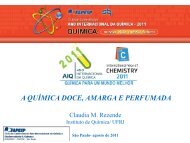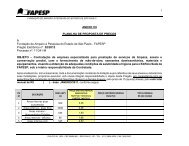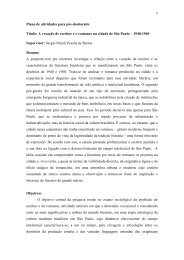You also want an ePaper? Increase the reach of your titles
YUMPU automatically turns print PDFs into web optimized ePapers that Google loves.
antOniO pRUdente canceR caRe centeR (apccc)<br />
main pUblicatiOns<br />
Achatz MI, Olivier M, Calvez FL, Martel-Planche G, Lopes<br />
A, Rossi BM, Ashton-Prolla P, Vargas FR, Casali da Rocha JC,<br />
Vettore AL, Hainaut P. 2007. Response to “Germline TP53<br />
R337H mutation is not sufficient to establish Li-Fraumeni<br />
or Li-Fraumeni-like syndrome”, by Ribeiro et al. Cancer Lett.<br />
247(2):356-8.<br />
Stolf BS, Santos MM, Simao DF, Diaz JP, Cristo EB, Hirata<br />
R Jr, Curado MP, Neves EJ, Kowalski LP, Carvalho AF. 2006.<br />
Class distinction between follicular adenomasand follicular<br />
carcinomas of the thyroid gland on the basis of their<br />
signatureexpression. Cancer. 106(9): 89 -900.<br />
Folgueira MA, Carraro DM, Brentani H, Patrao DF, Barbosa<br />
EM, Netto MM, Caldeira JR, Katayama ML, Soares FA, Oliveira<br />
CT, Reis LF, Kaiano JH, Camargo LP, Vencio RZ, Snitcovsky IM,<br />
Makdissi FB, e Silva PJ, Goes JC, Brentani MM. 2005. Gene<br />
expression profile associated with response to doxorubicinbased<br />
therapy in breast cancer. Clin Cancer Res. 11:7434-43.<br />
Gomes LI, Esteves GH, Carvalho AF, Cristo EB, Hirata R Jr,<br />
Martins WK, Marques SM, Camargo LP, Brentani H, Pelosof A,<br />
Zitron C, Sallum RA, Montagnini A, Soares FA, Neves EJ, Reis<br />
LF. 2005. Expression profile of malignant and nonmalignant<br />
lesions of esophagus and stomach: differential activity<br />
of functional modules related to inflammation and lipid<br />
metabolism. Cancer Res. 65:7 27-36.<br />
Reis EM, Ojopi EP, Alberto FL, Rahal P, Tsukumo F, Mancini UM,<br />
Guimaraes GS,Thompson GM, Camacho C, Miracca E, Carvalho<br />
AL, Machado AA, Paquola AC, Cerutti JM, da Silva AM, Pereira<br />
GG, Valentini SR, Nagai MA, Kowalski LP, Verjovski-Almeida S,<br />
Tajara EH, Dias-Neto E, Bengtson MH, Canevari RA, Carazzolle<br />
MF, Colin C, Costa FF, Costa MC, Estecio MR, Esteves LI, Federico<br />
MH, Guimaraes PE, Hackel C, Kimura ET, Leoni SG, Maciel RM,<br />
Maistro S, Mangone FR, Massirer KB, Matsuo SE, Nobrega<br />
FG, Nobrega MP, Nunes DN, Nunes F, Pandolfi JR, Pardini MI,<br />
Pasini FS, Peres T, Rainho CA, dos Reis PP, Rodrigus-Lisoni FC,<br />
Rogatto SR, dos Santos A, dos Santos PC, Sogayar MC, Zanelli<br />
CF. 2005. Head and Neck Annotation Consortium. Large-scale<br />
transcriptome analyses reveal new genetic marker candidates<br />
of head, neck, and thyroid cancer. Cancer Res. 65: 693-9.<br />
Stolf BS, Abreu CM, Mahler-Araujo MB, Dellamano M, Martins<br />
WK, de Carvalho MB, Curado MP, Diaz JP, Fabri A, Brentani H,<br />
Carvalho AF, Soares FA, Kowalski LP, Hirata Jr. R, Reis LF. 2005.<br />
Expression profile of malignant and nonmalignant diseases<br />
of the thyroid gland reveals altered expression of a common<br />
set of genes in goiter and papillary carcinomas. Cancer Lett.<br />
227:59-73.<br />
Meireles SI, Cristo EB, Carvalho AF, Hirata Jr. R, Pelosof A, Gomes<br />
LI, Martins WK,Begnami MD, Zitron C, Montagnini AL, Soares<br />
FA, Neves EJ, Reis LF. 2004. Molecular classifiers for gastric<br />
cancer and nonmalignant diseases of the gastric mucosa.<br />
Cancer Res. 64: 255-65.<br />
Brentani H, Caballero OL, Camargo AA, Da Silva AM, Da Silva<br />
WA Jr, Neto ED, Grivet M, Gruber A, Guimaraes PE, Hide W, Iseli<br />
C, Jongeneel CV, Kelso J, Nagai MA, Ojopi EP, Osorio EC, Reis EM,<br />
Riggins GJ, Simpson AJ, De Souza S, Stevenson BJ, Strausberg<br />
RL, Tajara EH, Verjovski-Almeida S, Acencio ML, Bengtson<br />
MH, Bettoni F, Bodmer WF, Briones MR, Camargo LP, Cavenee<br />
W, Cerutti JM, Andrade LE, Dos Santos PC, Costa MC, Da Silva<br />
IT, Estecio MR, Sa Ferreira K, Furnari FB, Faria M Jr, Galante PA,<br />
Guimaraes GS, Holanda AJ, Kimura ET, Leerkes MR, Lu X, Maciel<br />
RM, Martins EA, Massirer KB, Melo AS, Mestriner CA, Miracca EC,<br />
Miranda LL, Nobrega FG, Oliveira PS, Paquola AC, Pandolfi JR, De<br />
Moura Campos Pardini MI, Passetti F, Quackenbush J, Schnabel<br />
B, Sogayar MC, Souza JE, Valentini SR, Zaiats AC, Amaral EJ,<br />
Arnaldi LA, De Araujo AG, De Bessa SA, Bicknell DC, De Camaro<br />
ME, Carraro DM, Carrer H, Carvalho AF, Colin C, Costa F, Curcio C,<br />
Da Silva ID, Da Silva NP, Dellamano M, El-Dorry H, Espreafico EM,<br />
Ferreira AJ, Ferreira CA, Fortes MA, Gama AH, Giannella-Neto D,<br />
Giannella ML, Giorgi RR, Goldman GH, Goldman MH, Hackel C,<br />
Ho PL, Kimura EM, Kowalski LP, Krieger JE, Leite LC, Lopes A, Luna<br />
AM, Mackay A, Mari SK, Marques AA, Martins WK, Montagnini A,<br />
Neto MM, Nascimento AL, Neville AM, Nóbrega MP, O’Hare MJ,<br />
Otsuka AY, De Melo AI, Paco-Larson ML, Pereira GG, Da Silva NP,<br />
Pesquero JB, Pessoa JG, Rahal P, Rainho CA, Rodrigues V, Rogatto<br />
SR, Romano CM, Romeiro JG, Rossi BM, Rusticci M, De Sa RG,<br />
Sant’ Anna SC, Sarmazo ML, E Lima De Silva TC, Soares FA, De<br />
Fatima Sonati M, De Freitas Sousa J, Queiroz D, Valente V, Vettore<br />
AL, Villanova FE, Zago MA, Zalcberg H. 2003. The generation and<br />
utilization of a cancer-oriented representation of the human<br />
transcriptome by using expressed sequence tags. Proc Natl Acad<br />
Sci USA. 100(23): 34 8-23.<br />
Camargo AA, Samaia HP, Dias-Neto E, Simao DF, Migotto IA,<br />
Briones MR, Costa FF, Nagai MA, Verjovski-Almeida S, Zago MA,<br />
Andrade LE, Carrer H, El-Dorry HF, Espreafico EM, Habr-Gama A,<br />
Giannella-Neto D, Goldman GH, Gruber A, Hackel C, Kimura ET,<br />
Maciel RM, Marie SK, Martins EA, Nobrega MP, Paco-Larson ML,<br />
Pardini MI, Pereira GG, Pesquero JB, Rodrigues V, Rogatto SR, da<br />
Silva ID, Sogayar MC, Sonati MF, Tajara EH, Valentini SR, Alberto<br />
FL, Amaral ME, Aneas I, Arnaldi LA, de Assis AM, Bengtson MH,<br />
Bergamo NA, Bombonato V, de Camargo ME, Canevari RA,<br />
Carraro DM, Cerutti JM, Correa ML, Correa RF, Costa MC, Curcio C,<br />
Hokama PO, Ferreira AJ, Furuzawa GK, Gushiken T, Ho PL, Kimura<br />
E, Krieger JE, Leite LC, Majumder P, Marins M, Marques ER, Melo<br />
AS, Melo M, Mestriner CA, Miracca EC, Miranda DC, Nascimento<br />
AL, Nobrega FG, Ojopi EP, Pandolfi JR, Pessoa LG, Prevedel AC,<br />
Rahal P, Rainho CA, Reis EM, Ribeiro ML, da Ros N, de Sa RG, Sales<br />
MM, Sant’anna SC, dos Santos ML, da Silva AM, da Silva NP, Silva<br />
WA Jr, da Silveira RA, Sousa JF, Stecconi D, Tsukumo F, Valente V,<br />
Soares F, Moreira ES, Nunes DN, Correa RG, Zalcberg H, Carvalho<br />
AF, Reis LF, Brentani RR, Simpson AJ, de Souza SJ. 200 . The<br />
contribution of 700,000 ORF sequence tags to the definition of<br />
the human transcriptome. Proc Natl Acad Sci USA. 98: 2 03-8.<br />
Pignon JP, Bourhis J, Domenge C, Designé L. Contribution of<br />
Kowalski LP. et al. 2000. Chemotherapy added to locoregional<br />
treatment for head and neck squamouscell carcinoma: three<br />
meta-analyses of updated individual data. Lancet. 355:949-53.<br />
Antonio Prudente Cancer Care Center (APCCC)<br />
Centro Antonio Prudente de Pesquisa<br />
e Tratamento do Câncer<br />
Rua Professor Antônio Prudente, 2 – Liberdade<br />
0 509-0 0 – São Paulo, SP – Brasil<br />
+55- -2 89-5000<br />
www.hcanc.org.br<br />
antOniO pRUdente<br />
canceR caRe centeR<br />
apccc<br />
ReseaRch, innOvatiOn<br />
and disseminatiOn centeRs (Ridc)<br />
main ReseaRcheRs<br />
Scientific Coordinator and Center Director<br />
Fernando Soares<br />
Innovation Coordinator<br />
Luiz Fernando Lima Reis<br />
Diffusion Coordinator<br />
Dirce Maria Carraro<br />
Principal Investigators<br />
Beatriz de Camargo<br />
Fernando Augusto Soares<br />
Luiz Fernando Lima Reis<br />
Luiz Paulo Kowaslki<br />
Researchers<br />
Ademar Lopes<br />
Adriana Abalen Martins Dias<br />
Alex Fiorini de Carvalho<br />
André Luiz Montagnini<br />
Benedito Mauro Rossi<br />
Dirce Maria Carraro<br />
Eduardo Jordão Neves<br />
Helena Paula Brentani<br />
Maria do Socorro Maciel<br />
Mario Mourão Neto<br />
Renata de Almeida Coudry<br />
Silvia Regina Rogatto<br />
Young Researchers and Post-Doctoral Researchers<br />
Claudia Malheiros Camillo-Coutinho<br />
Katia Cândido Carvalho<br />
Marcilei Buim<br />
Nair Hideko Muto<br />
Doctoral Students<br />
Ana Helena Pagotto<br />
Anna Estela Luia Coló<br />
Bianca Diana Barreto<br />
Cecília Maria Lima da Costa<br />
Elisa Napolitano Ferreira<br />
Fabio de Simone Piccoli<br />
Fernanda Rocha Rojas Ayala<br />
Isabela Werneck da Cunha<br />
Maria Cristina Rodrigues<br />
Mariana Maschietto<br />
Nadia Pereira de Castro<br />
Master Students<br />
Leticia Koch Lerner<br />
Camila Melo<br />
Scientific Initiation Students<br />
Luana de Andrade Franco<br />
Laser Capture Microdissection System Veritas TM<br />
The Antonio Prudente Cancer Care Center (APCCC),<br />
based at Cancer Hospital, in São Paulo, was approved by<br />
FAPESP in 2000. Its primary goal is to contribute to the<br />
advancement of cancer prevention, diagnosis and treatment.<br />
Following the best standards recognized worldwide, we<br />
aim to develop new tools to improve patient care. In 2000,<br />
research projects were primarily focused on gene discovery,<br />
mutation detection, differential expression between normal<br />
and tumor tissues, and epidemiology of HPV.<br />
During its first five years, the APCCC got involved in<br />
a major sequencing effort, financed by FAPESP and the<br />
Ludwig Institute for Cancer Research (LICR), the Human<br />
Cancer Genome Project (HCGP). This project ended in 200 ,<br />
with a significant contribution to the human transcriptome,<br />
producing an excess of million ESTs generated from<br />
normal and tumor tissues. The APCCC contributed with<br />
more than 99% of tissue-derived RNA. Because of that,<br />
APCCC developed procedures and protocols for the creation<br />
of a tumor bank that allows the extraction of high quality<br />
DNA/RNA/protein.<br />
At the same time, efforts were also dedicated to the<br />
establishment of cDNA microarray and tissue microarray<br />
platforms. Finally, we also invested heavily on bioinformatics<br />
in order to have these platforms integrated with our tumor<br />
bank and samples linked to clinical data, and acquired<br />
the expertise to analyze both platforms. This integrated<br />
effort for quantitative analysis of transcripts was the major<br />
achievement during that period and enabled us to identify<br />
new molecular markers for diagnosis and prognosis.<br />
For the 2005-2008 period, we focused our research<br />
project on a small number of tumors (Head and neck,<br />
Sarcomas, Wilms’ Tumor, and Breast). Thus, taking advantage<br />
of the previously built platforms, we were in a position<br />
to address clinically relevant questions: Can we improve<br />
diagnosis? Can we evaluate prognosis? Can we predict<br />
response to therapy? For the second period of RIDC (2005-<br />
2008) we succeeded in the identification of new diagnostic<br />
and prognostic markers for the proposed tumors.
antOniO pRUdente canceR caRe centeR (apccc)<br />
Main ReseaRch Topics<br />
During its existence, the APCCC has been<br />
characterized by the effort to bring together basic<br />
researchers and medical staff in order to produce new<br />
advances in tumor diagnosis and etiology, prognostic<br />
markers, and tools to predict response to therapy. It is<br />
a definition of translational research with the aim to<br />
benefit our patients.<br />
APCCC has been working with gene expression<br />
transcriptomic studies. We participated in HCGP<br />
working with ORESTES and contributed with more than<br />
one million sequences of different tumors and their<br />
normal counterparts (Camargo AA et al. 200 . Proc Natl<br />
Acad Sci USA. 98(21): 2 03-8; Brentani H et al. 2003. Proc<br />
Natl Acad Sci USA. 100(23): 34 8-23). We worked with<br />
SAGE on establishing different mathematical models<br />
of analysis (Vêncio RZ et al. 2007. BMC Bioinformatics.<br />
8:246; Barrera J et al. 2007. BMC Bioinformatics.<br />
8: 69), and have also been working with microarrays<br />
contributing with important classifiers that may help in<br />
clinical practice.<br />
Several facilities have been organized as follows:<br />
tumor and DNA/RNA bank, DNA/RNA extraction facility,<br />
TMA facility, and gene expression facility. We them<br />
focused our efforts on four types of tumor: head and<br />
neck carcinomas, sarcomas, Wilms’ tumor, and breast<br />
carcinomas.<br />
The head and neck tumors front has been<br />
approached in order to recognize predictors of<br />
response for chemo/radiotherapy in larynx squamous<br />
cell carcinoma. By using biopsies taken before<br />
treatment, the gene expression profile of a group of<br />
2 responders was compared with a second group<br />
of 4 non-responders. After mathematical analysis,<br />
four trios of genes were identified that could predict<br />
responsiveness to treatment.<br />
We have also analyzed molecular signatures in<br />
sarcomas. Mesenchymal tumors are unusual, but they<br />
have significant morbidity and mortality. Our main<br />
effort in the last three years was to identify classifiers<br />
able to separate locally aggressive tumors but without<br />
ability to develop metastasis from potential metastatic<br />
sarcomas. We have used fibromatosis as a tumor model<br />
with high local aggressiveness and fibrosarcomas as a<br />
model of metastatic sarcomas.<br />
The third branch of the Center is related to<br />
molecular markers as predictors of adverse outcome<br />
in Wilms’ tumors. For this, we have tested blastemal<br />
predominant Wilms’ tumors sensible and resistant to<br />
chemotherapy. By using SAGE, we have selected 4<br />
differentially expressed genes.<br />
Finally, the breast carcinoma front was approached<br />
by two different projects. One of them studied the<br />
validation of Adam23 hypermethylation (HyMe) as<br />
an independent prognostic factor, and the second<br />
aims to explore the transcriptional variability caused<br />
by alternative splicing to identify breast carcinomaassociated<br />
splicing variants.<br />
Laser Capture Microdissection Procedure<br />
suMMaRy of ResulTs<br />
To daTe and peRspecTives<br />
Our main research focus is on translation<br />
research in order to improve diagnosis and<br />
prognosis of the tumors, and identify predictors<br />
of treatment response. Nowadays our aims are<br />
concentrated on tumors of head and neck, soft<br />
tissues, breast and Wilms’ tumor.<br />
The breast carcinoma front was approached<br />
by two different projects. One of them studied the<br />
validation of Adam23 hypermethylation (HyMe) as<br />
an independent prognostic factor, and comprised<br />
three segments: Adam23 regulation of the activation<br />
of avb3 integrin; Adam23 HyMe in plasma samples<br />
from breast cancer patients; and Adam23 HyMe<br />
and detection of micrometastasis in sentinel lymph<br />
nodes. The second project in the breast carcinoma<br />
section aims to explore the transcriptional variability<br />
caused by alternative splicing to identify breast<br />
carcinoma-associated splicing variants.<br />
Also, we have analyzed molecular signatures<br />
in sarcomas. The main effort is to identify classifiers<br />
that are able to separate locally aggressive tumors,<br />
but without ability to develop metastasis from<br />
potential metastatic sarcomas.<br />
A third segment of APCCC’s proposal is related<br />
to predictors of response for chemo/radiotherapy in<br />
larynx squamous cell carcinoma. After mathematical<br />
analysis, four trios of genes were identified that<br />
could predict responsiveness to the treatment.<br />
The last project is related to molecular<br />
markers as predictors of adverse outcome in<br />
Wilms’ tumors. For this, we have tested blastemal<br />
predominant Wilms’ tumors sensible and resistant<br />
to chemotherapy. Five genes showed a differential<br />
expression between relapsed and non-relapsed<br />
WT samples with statistical significance (p


